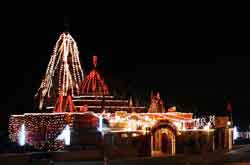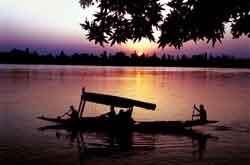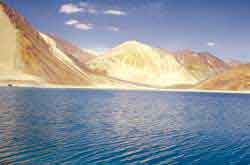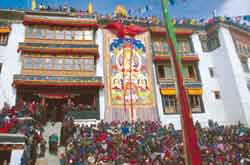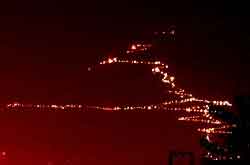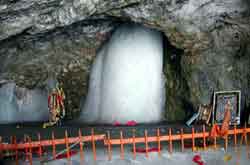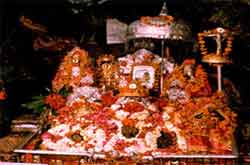Zanskar
The western parts of Ladakh comprising the river valleys, which are drained and formed by the Himalayan tributaries of the high Indus, constitute Zanskar district. About 20 kms south-east of Rangdum stands the Panzila axis, across which lies Zanskar, the most isolated of all the trans-Himalayan valleys. The Penzila pass (4,401m) is a picturesque tablet and surrounded by snow-covered peaks.
As the Zanskar road winds down the steep slopes of Penzi-la to the head of the Stod valley, the majestic "Drang-Drung" glacier looms into full view. A long and winding river of ice and snow, "Drang-Drung" is perhaps the largest glacier in Ladakh, outside the Siachen formation. It is from the cliff-like snout of this extensive glacier that the Stod or Doda tributary of the Zanskar River rises.
Zanskar is a tri-armed valley system situated between the Great Himalayan Range and the Zanskar mountains, the three arms radiating star-like towards the west, north and south from a wide central expanse.
Here the Zanskar River comes into being by the confluence of its two Himalayan tributaries, the Stod/Doda and the Lingti-Tsarap rivers. It is mainly along the course of this valley system that the region’s approximately 14,000 strong, mainly Buddhist population, live. Spread over an estimated geographical area of 5000 sq kms of mountainous territory, Zanskar is surrounded by high-rise mountains and deep gorges.
It remains inaccessible for nearly 8 months a year due to heavy winter snowfall resulting in closure of all access passes, including the Penzi-la. This geographical isolation and the esoteric nature of Buddhism practised here have enabled its inhabitants to preserve their identity, so that to-day Zanskar is the least interfered with microcosms of Ladakh. Closer observation of the lifestyle evokes admiration for a people who have learnt to live in perfect harmony with the unique environment.
Within the mountainous ramparts of this ‘Shangri-La’ are a number of ancient yet active monastic establishments. Some of these foundations have evolved around remote mountain caves, which are by legend associated with famous Buddhist saints. These are in fact the main places of attraction for the visitors in the area, in addition to the haunting beauty of the spectacular landscape and the ancient culture.
How to Reach Zanskar - The 240-km long Kargil-Padum road remains open from early July to mid-October. The J&K State Road Transport Corporation operates bus service between Kargil and Padum. But tourist groups can charter deluxe buses to visit Zanskar, including sightseeing within the valley.
Jeep and taxis can also be hired at Kargil, but the charges are high due to the difficult road conditions. During June and early July, prior to opening of the road, it is recommended to walk into Zanskar from Panikhar or Parkachik. The week- long trek provides an opportunity to enjoy the unending grandeur of the Himalayas besides the experience of interacting with the inhabitants of the villages, which otherwise passes by fleetingly while travelling by bus or taxi. In June, summer is at its height in the region and the climate is ideal for trekking along a route free from vehicular traffic when the area is freshly rejuvenated into life during this period after months of frigid dormancy.
Hotel Stay & other Accomodation - The Tourist Complex at Padum has furnished rooms. There is catering arrangement within the complex and a camping place nearby for tourists travelling with personal tents.
There are also several small hotels in Padum where rooms with basic facilities are available at reasonable rates. At Karsha, basic accommodation is available in guest houses. In distant villages like Stongdey, Zangla, Sani, etc., accommodation can be sought from the villagers at negotiable rates. Some monasteries may also take in guests, though more as a gesture of goodwill than on commercial consideration. Of course, the guest is expected to compensate the monastery suitably.
Travel Tips - Zanskar experiences drastic fluctuations in the daily temperature even during the height of summer. While the days are pretty warm, even hot at times due to the desert effect, the evenings can become quite chilly and require additional clothing. It is advisable to be prepared with a pullover and a down jacket. Other essential items include a sturdy pair of walking shoes (with strong rubber or synthetic soles for grip), a good sleeping bag and a pair of woollen socks or some thick cotton socks. It is also essential to bring along a good quality tent if one intends to travel or trek around by oneself, and a good rucksack for back packing. It is also important to carry provisions from Srinagar, Leh or Kargil if a longer tour of the adjoining villages is intended.

